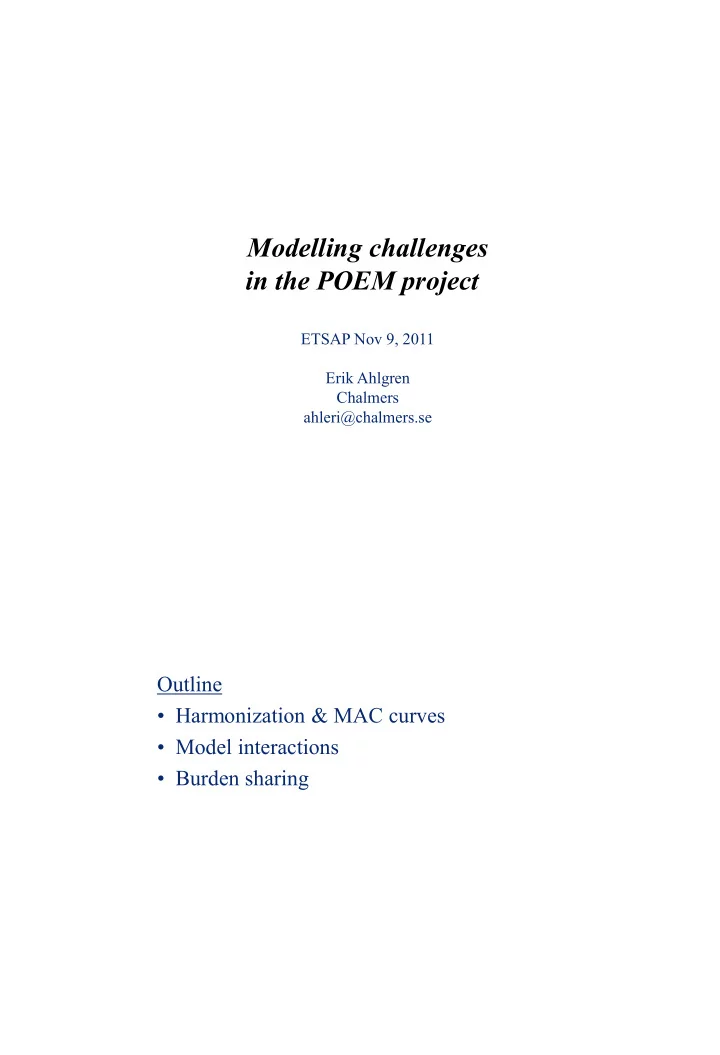

Department of Energy Technology Modelling challenges in the POEM project ETSAP Nov 9, 2011 Erik Ahlgren Chalmers ahleri@chalmers.se Department of Energy Technology Outline • Harmonization & MAC curves • Model interactions • Burden sharing
Department of Energy Technology Policy Options to engage EMerging Asian economies in a post-Kyoto regime – POEM (EC FP7) Project aim: contribute to knowledge on consequences of different ways of reaching both development and climate objectives in India and China. Hypothesis: it is only possible to achieve both objectives through combinations of policies and measures at international and national levels. Department of Energy Technology CO2 emissions China
Department of Energy Technology Department of Energy Technology Issues • Can the different objectives be reached simultaneously in a clever way ? • What is the “true” mitigation cost of different pathways ? • Are cost and benefits path dependent ? • Potential impact of national and international policies?
Department of Energy Technology Climate or development first? Department of Energy Technology Participating organisations • Chalmers University of Technology, Sweden • Netherlands Environmental Assessment Agency, The Netherlands • Tshinghua University, China • Center for Energy and Environmental Policy Research, Chinese Academy of Sciences – Beijing Institute of Technology, China • Kiel Institute for the World Economy, Germany • Indian Institute of Management, Ahmedabad, India • Indian Institute of Economic Growth, India
Department of Energy Technology Global and national models • the global climate model FAIR connected to global energy model TIMER, • the global GE model DART, • the global population and health model PHOENIX, • national macro-economic models, • national energy system MARKAL models. Department of Energy Technology Where to start? • Model comparisons • Model harmonizations – GDP – Fuel prices – Technology characteristics – MAC curves
Department of Energy Technology Global - Population 12000 10000 8000 Million persons PBL IfW 6000 IIASA-B1 IIASA-B2 4000 IIASA-A2r 2000 0 1990 2000 2010 2020 2030 2040 2050 2060 Department of Energy Technology India - Population 2000 1800 1600 PBL 1400 Million persons 1200 IfW 1000 IIMA 800 IIASA-B1 600 IIASA-B2 400 IIASA-A2r 200 0 1990 2000 2010 2020 2030 2040 2050 2060
Department of Energy Technology Global average GDP/CAP 25000 20000 PBL 15000 IfW USD 2005 IIASA-A2r IIASA-B2 10000 IIASA-B1 IfW-harm 1 5000 0 1990 2000 2010 2020 2030 2040 2050 2060 Department of Energy Technology GDP/cap - China 40000 35000 PBL 30000 IfW 25000 USD 2005 BIT 20000 Tsinghua 15000 IIASA-B1 IIASA-B2 10000 IIASA-A2r 5000 IfW-harm 1 0 1990 2000 2010 2020 2030 2040 2050 2060
Department of Energy Technology India - GDP/cap 12000 10000 PBL 8000 IfW USD 2005 IIMA 6000 IIASA-B1 IIASA-B2 4000 IIASA-A2r IfW-harm 1 IEG 2000 0 1990 2000 2010 2020 2030 2040 2050 2060 Department of Energy Technology Oil price IEA-Ref scenario 350 IEA-450 ppm scenario EIA-Medium 300 EIA-High 250 EIA-Low US$(2005) per barrel PBL-World 200 IfW-China 150 IfW-India PBL-China 100 PBL-India IIMA 50 IfW-China-harm 0 IfW-India-Harm 2000 2005 2010 2015 2020 2025 2030 2035 2040 2045 2050 Years
Department of Energy Technology Non-harmonized Global 120 100 CO2 price (US$/tCO2) PBL-2020 80 IfW-2020 60 PBL-2050 40 IfW-2050 20 0 0% 10% 20% 30% 40% 50% 60% 70% 80% Abatement (%) Department of Energy Technology Non-harmonized China 100 90 80 (CO2 price (US$/tCO2) PBL - 2020 70 IfW-2020 60 BIT-2020 50 PBL - 2050 40 30 IfW-2050 20 BIT-2050 10 Tsinghua 0 MIT-EPPA-2020 0,0% 20,0% 40,0% 60,0% 80,0% 100,0% Abatement (%)
Department of Energy Technology Department of Energy Technology
Department of Energy Technology Burden sharing regimes Department of Energy Technology
Department of Energy Technology Burden sharing regimes – results for China Department of Energy Technology Regimes analyzed • Intensity targets • CDC (common but differentied convergence)
Department of Energy Technology Results to be reported in a year. Thank you.
Recommend
More recommend